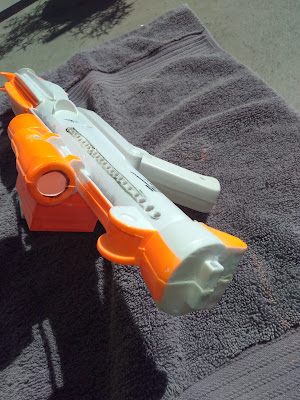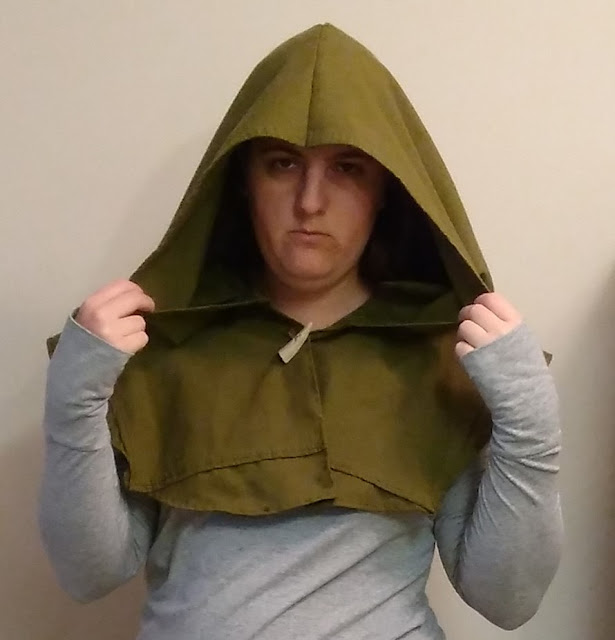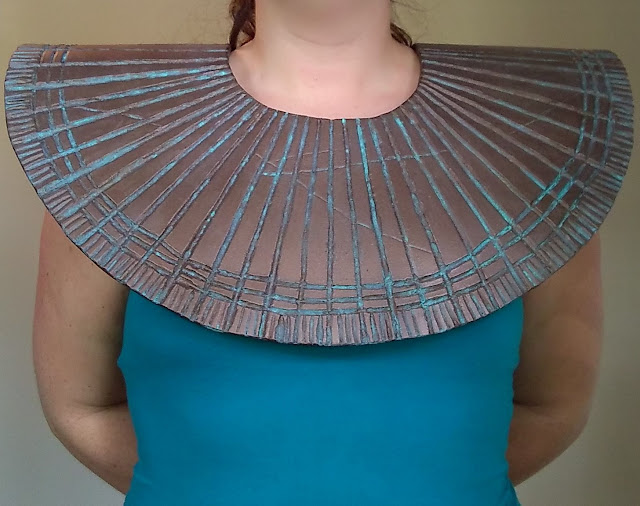How to make a budget E-11 blaster
Although the Iden Versio carries a variety of weapons in the game, the basic stormtrooper's E-11 blaster rifle is at once easier to source and iconic in its own right. I've done some simple painting of nerf guns for generic sci-fi costumes, but I've never tried to recreate a specific blaster. Given the current availability of basic toy blasters of well-known Star Wars weapons, it seems like a good time to give it a go without shelling out a huge amount of money.
Materials
-Rubie's Costumes Star Wars Rebels Stormtrooper Blaster
-Satin black spray paint
-Primer spray paint
-Clear coat enamel spray paint
-Liquid Nail
-Silver metallic lustre wax
-Silver paint marker
Tools
-Dremel with drill bit, carving, and sanding attachments
-Drill
-Superglue
1. Gather the materials
Getting all the parts together can be as much of a challenge as the actual project. I got the blaster to modify from Target, a Rubie's Costumes Star Wars Rebels Stormtrooper Blaster for $12. I got it in the rush for Halloween props in 2018, and I suspect they'll become harder to find as time wears on. It's about the right size, but there are definitely some differences between this prop and the on-screen E-11s.
I also collected a few odds and ends I keep in my "greeblies" (AKA junk), including a two-way coax cable splitter I found in a parking lot, parts of an old ballpoint pen, dollar store flashlights and laser pointers, old car charging cables, etc. These parts will come in handy when creating the "power cylinder" assembly attached to the magazine. You can custom order 3D-printed parts to make an E-11 replica, but it seems like that takes some of the fun out of it. Also I don't have a 3D-printer or the extra money for buying too many custom parts.
2. Plan of attack
I know the idea of modding a prop is generally to make it more screen accurate, but you should set goals of just how far you're prepared to go. If you want a completely screen-accurate replica, you often either need a lot of money to buy it from someone who painstakingly did the work, or the skill and time to reverse engineer the methods for yourself. At this point, I'm operating on limited skillsets, so I made some more modest goals. I wanted to experiment with some of the tutorials I'd seen, but still keep it low-budget. And also to try out some new techniques and skills along the way. Simple right?
So I took some pictures of the blaster and decided what I'd like to change it make it a little more authentic. Some of my goals?
-Drill vent holes, muzzle sights, scope front
-Carve out space under scope rail and fake D-ring
-Fill screw holes leftover from assembly
-Sand to get rid of toy printing and molding errors
-Paint using primer, try out satin black, and weather with silver wax
-Finish with power cylinders, simple muzzle lights, assorted greeblies
Here's what a great E-11 replica from Shepperton Design Studios looks like:
Fantastic, right? Great craftsmanship. So my goal was to modify my blaster to look more like this replica. I paged through a lot of E-11 blaster builds and found a great tutorial that also modifies the Rubie's Costumes Star Wars Rebels model by Happy Trooper. It's a very detailed, inventive, and cost-effective video tutorial, highly recommend it. If anyone's interested in putting stormtrooper builds and blaster pistol/rifle builds definitely check it out.
3. Drilling and carving
So the first modifications I made were using the Dremel. I drilled a pilot hole and then expanded the hole with the carving attachment on the front eyepiece on the scope, the vent holes along the barrel, and the front sights. I also expanded the hole in the muzzle. I drilled pilot holes and then carved out the area under the scope, which also accidentally cut into the stock beneath. I was kicking myself on that, but I don't think it's too noticeable.
On the reverse side I drilled a series of holes along the side where there's normally a slit with a coil inside. I originally was going to hollow the whole slit and install something to look like that, but discovered that the whole blaster was tightly glued together, so installation would be more than I wanted to tackle. Also, I carved off the fake D-ring on the butt of the rifle, and drilled holes on either end of where the D-ring would be attached.
4. Sanding
I used a sanding drum to remove the raised printing and smooth out the drilled areas. That takes care of the major stuff, but it helps to go back and use some fine-grained sandpaper to hand sand those trouble spots, and to lightly go over the entire blaster with it. This light sanding is supposed to help the primer adhere, which helps with the whole process.
5. Filling screw holes
For this Rubie's Costumes prop, the screws for holding the halves of the blaster together are pretty useless. I tried separating the parts to better control the modding process, but found the screwheads mostly stripped and the halves were held tightly with glue. So I decided to go ahead and fill in the screw holes on the reverse side, to make it look less like a plastic prop. You can use a lot of stuff like Bondo body filler, epoxy, etc., but I went for a cheaper option with Liquid Nail. Pretty easy to use, just squeeze into screw holes and let it set. Keep an eye on it though, the material settles and might need to be topped off. If in doubt, add enough to poke out the top. After 24 hours curing, you can sand off the excess.
6. Adding primer
I don't usually use primer, but this time I made the plunge. Primer is good for painting because it is especially designed to adhere to smooth surfaces, and give the next layer of paint something to stick to. So I set up a painting area outside for ventilation, and hung the blaster from some wire. I added primer with sweeping motions and slowly covered the entire blaster. I let it dry for about 20 minutes.
7. Sanding again
Inevitably there's going to be a few paint drips or uneven spots, and the primer also reveals mistakes from earlier. I took the opportunity to apply a little sandpaper on those spots.
8. A little more primer
Added another light coast of primer, since the sanding is a little overenthusiastic.
9. Painting
Based on readings of other people making much more detailed E-11 blasters, I used Rustoleum Satin Black spray paint. I've been using a semi-gloss for experiments, but it is a bit shiny and doesn't really have than gunmetal look. After a couple of coats, I hung to dry for a few hours.
10. Getting cocky
So I let it dry and brought it inside to cure overnight. I hung it in the laundry room, thinking 'hey what could go wrong?' Turns out lots of little things. It was still a little sticky, which attracted all the floating lint. I did a little light sanding, and found some spots that I'd missed with the painting. And then I figured I needed another coat to fix it all. So I hung it, sprayed it, and then the wind took it and knocked it to the ground. So now there's mulch stuck to it. I tried sanding off the mulch before it was dry, and it only made it way worse. Soon I had paint flaking, primer flaking, the works. In short, I got way too cocky and added gasoline on a fire. Note: this is what a single mistake and a shortage of patience can get you.
10. Starting over
Cut to several months later. I put aside the project for awhile, and found a better space for painting. I ended up chipping and sanding off most of the original paint and primer. With the additional sanding and cleaning, the hope was it would give a better surface for the primer to adhere to. I re-primed and add a few layers of black paint, then finally topped it with clear coat enamel, being sure to wait until it was completely dry for each coat.
11. Making the power cylinders
When using a plastic model of an E-11, they almost never have power cylinders on them. You may ask what power cylinders are, but really I don't have much of a clue either. But they are kind of neat extra element that gets you closer to screen-accurate and make it look less like a molded plastic kid's toy. You can buy the custom parts, or make a something that looks pretty close. Being the cheapskate/creative I am, I did the latter.
 |
| Close-up of the power cylinders and wires on blaster replica made by Shepperton Design Studios |
I made this assembly out of weird scraps I've collected. For the cylinders, I used a beat-up two-way coax cable splitter that I found abandoned in a parking lot. I spray-painted it black to match the rest of the blaster. I then cut up the cord of an old-school cell phone charger into two pieces. On either side of the coax splitter, hook one end of the cord to the "cylinder" and feed the other end into the gray tube there. Not a clue what the gray tube actually was, except that it was a piece inside of a pen. But it was the right size to tightly contain the two ends.
To attach it to the blaster, drill a large-bore hole into the block by the "scope". This is where the gray pen tube is going to be fixed. I used the largest drill bit I had and it wasn't quite big enough, so I sanded away the edges of the hole with my Dremel. Be careful though, drilling into this plastic with too much gusto might cause a lot of damage. Gently brush away the plastic scraps, as getting rid of it later will difficult. I'm still learning the basics of my drill and Dremel, so I'm unjustifiably proud. At this stage I was doing my best not to screw up these last few steps (you know that pun wasn't intended but it fits pretty well).
Next drip some superglue along the outside of the gray tube, and then snugly insert the tube into the drill hole. Hold in place until it sets up, and then apply glue to the underside of the coax cable splitter and place. Allow to dry.
12. Painting silver details
For the silver patch on the right side of the blaster, I used a silver paint marker to fill in the depression.
Next, use the metallic lustre wax (AKA "rub'n'buff") to give the blaster the appearance of heavy wear. Here on Earth, the steel of gun barrels and parts are treated to prevent rust, through old-school "bluing" or the more modern "Parkerizing" of the weapon. In either of these processes the steel is turned to a matte black. When you look at guns that are well-worn, the silver of the steel peeks through along the edges that have been scraped, buffed, and otherwise handled the most. Applying a little of the metallic wax with a stiff paintbrush in a haphazard fashion along the outermost edges mimics this ageing and heavy use. Definitely would advise the wax over using a silver paint marker or acrylic paint applied with a brush, either way the paint is too liquid and it shows in the application. There aren't any fixed rules on where the wax should go, but Ithink some key points are along the barrel's fins and the muzzle of the blaster. Add a little at a time until you're satisfied.
And there you have it, a battle-worn, budgeted E-11 blaster. Not exactly a precision screen-accurate custom-build with all the bells and whistles, but something beginner craftspeople like myself can be proud of. For other great E-11 blaster builds that inspired this version see below:
Stormtrooper E-11 Blaster Prop Build. Happy Trooper. https://happytrooper.com/?p=4860
Starwars Blaser Gun for Costume. IamTheCreator. https://www.instructables.com/id/Starwars-blaster-gun-for-costume/
Good luck and keep crafting!


























Comments
Post a Comment